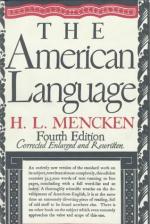
|
| Name: _________________________ | Period: ___________________ |
This test consists of 5 multiple choice questions, 5 short answer questions, and 10 short essay questions.
Multiple Choice Questions
1. Which defender of Americanisms cited by Mencken in Chapter 1.3 states that "Language is made by the people"?
(a) Edgar Jepson.
(b) William Archer.
(c) George Ade.
(d) Richard Aldington.
2. Which of the following groups of foreign immigrants does Mencken not attribute influence over American English in Chapter 6.4?
(a) Slavic peoples.
(b) Italians.
(c) Russian Jews.
(d) South-Pacific Asian Islanders.
3. What Anglo-Saxon word does Mencken report the colonists refused to replace with an Old Norse word of similar meaning?
(a) Hale.
(b) Sick.
(c) Vapid.
(d) Ill.
4. Which of the following groups of immigrants does Mencken claim have a profound effect on not only the American vocabulary, but also its pronunciation and idiom?
(a) Scottish.
(b) Irish.
(c) Italian.
(d) Danish.
5. What word does Mencken find Dr. John Dewey using in place of the word "opium?"
(a) Dope.
(b) Crack.
(c) Skag.
(d) Poppy.
Short Answer Questions
1. According to Mencken at the beginning of Chapter 1.3, what do the novelists and newspapermen on either side of the Atlantic ocean delight in?
2. In terms of politics, an American candidate "runs" for office. What does an English candidate do?
3. What American writer does Mencken claim likely inspired envy in British writers?
4. According to Mencken, which title is subject to the greatest divergence in usage?
5. Which of the early presidents does Mencken identify as archetypal of the new American?
Short Essay Questions
1. What does Mencken mean by saying that Americans have "a habit of achieving short-cuts in speech by a process of agglutination"?
2. What, in Chapter 1.3, is the main conflict of ideas that Mencken puts forth?
3. Upon what does Mencken claim the art of American prose is based, in Chapter 9.2?
4. As explained in Chapter 6.4, why are Americans more conceding to foreign loan-words than the English are?
5. What are the different significations of "guy" in America and England, as described by Mencken?
6. To what does Mencken ascribe the withdrawal of the National Education Association from the simplified spelling campaign?
7. What principally causes the difficulty of the English people understanding the American speech as explained in Chapter 1.3?
8. What characterizes the divergences of language usage that are cataloged in Chapter 4.2?
9. From what tradition do names such as Faith, Hope, and Charity come, and what is significant about the continued use of these names?
10. What is the most common incorrect usage of the adjective in vulgar American?
|
This section contains 718 words (approx. 3 pages at 300 words per page) |

|




